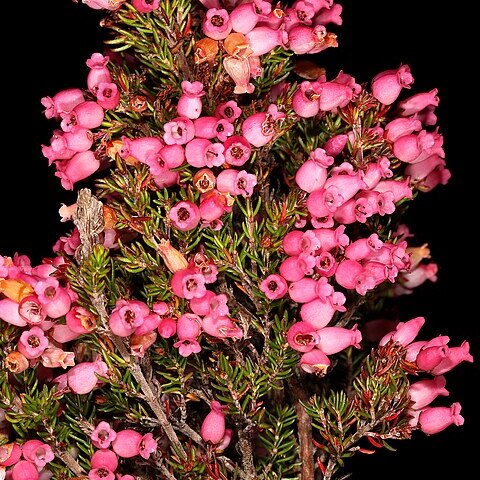Erect shrub up to about 45 cm (1 1/2 ft). Branches grey-pubescent. Leaves 4-nate, 4 mm long, erect to spreading, linear, keeled, sulcate, glabrous or glabrescent. Flowers 4-nate terminal, numerous on short branchlets forming a pseudo-raceme; peduncles 2-4 mm long, puberulous, red; bracts median to remote, small. Sepals 1.5-2.5 mm long, mostly ovate-oblong, rarely subovate, acute or acuminate, keeled, glabrous, glossy. Corolla 4-6 mm long, urceolate or ovoid-urceolate, narrowed at the throat, dry glabrous, white or pale rose; lobes the length of the tube, spreading or, rarely erect, sometimes darker coloured. Filaments filiform, curved; anthers included, 0.5-0.8 mm long, lateral, more or less deltoid with rounded angles, occasionally narrower, the width usually equal to the length, sometimes a little less, minutely ciliate, appendiculate; pore 1/3-2/3 the length of the cell; crests 1/2-2/3 the length of the cells, occasionally about as long, immediately deflexed close to the cells, narrow, fringed, mostly entire or slightly lobed or lacerate. Ovary turbinate, glabrous; style mostly included; stigma capitate.
Erect shrub to dwarf shrub, 0.3-0.5(-1.0) m high. Leaves erect or spreading, ± 4.2 mm long, linear, acute, keeled, sparsely hairy. Flowers crowded at ends of short branchlets forming a pseudo-raceme. Calyx sepals 1.5-2.6 mm long, ovate lanceolate, acute or acuminate, keeled, glabrous, glossy, dark red. Corolla 4.2-6.3 mm long, urceolate or ovoid-urceolate, wide-mouthed, white, pale rose to bright pink; lobes large and well spreading, 1/5-1/4 length of tube. Anthers included, variable in length and shape, 0.5-0.8 mm long, transversely semi-ovate to oblong-cuneate, minutely ciliolate on margins, crested; pore 1/3-2/3 length of theca; crests deflexed close to theca, subulate to lanceolate, finely fimbriate, entire to lacerate, 1/2-2/3 length of theca. Ovary glabrous; style included; stigma capitate. Flowering time June-Apr.
Erect shrublet to 1 m. Flowers small, ovoid-urn-shaped, bright pink.

